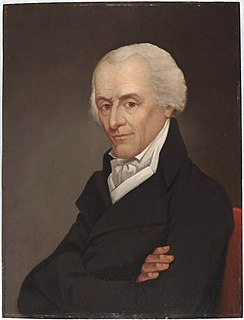
Elbridge Thomas Gerry was an American politician and diplomat. As a Democratic-Republican he served as the fifth vice president of the United States under President James Madison from March 1813 until his death in November 1814. The political practice of gerrymandering is named after him.

Frederic Edwin Church was an American landscape painter born in Hartford, Connecticut. He was a central figure in the Hudson River School of American landscape painters, best known for painting large landscapes, often depicting mountains, waterfalls, and sunsets. Church's paintings put an emphasis on realistic detail, dramatic light, and panoramic views. He debuted some of his major works in single-painting exhibitions to a paying and often enthralled audience in New York City. In his prime, he was one of the most famous painters in the United States.

William Kissam Vanderbilt I was an American heir, businessman, philanthropist and horsebreeder. Born into the Vanderbilt family, he managed his family's railroad investments.
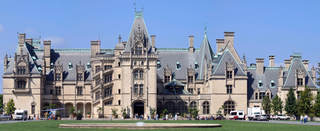
From the late 1870s to the 1920s, the Vanderbilt family employed some of the United States's best Beaux-Arts architects and decorators to build an unequalled string of townhouses in New York City and East Coast palaces in the United States. Many of the Vanderbilt houses are now National Historic Landmarks. Some photographs of Vanderbilt's residences in New York are included in the Photographic series of American Architecture by Albert Levy (1870s).

Richard Morris Hunt was an American architect of the nineteenth century and an eminent figure in the history of American architecture. He helped shape New York City with his designs for the 1902 entrance façade and Great Hall of the Metropolitan Museum of Art, the pedestal of the Statue of Liberty, and many Fifth Avenue mansions since destroyed.

The Château de Chantilly is a historic French château located in the town of Chantilly, Oise, about 50 kilometres north of Paris. The site comprises two attached buildings: the Petit Château built around 1560 for Anne de Montmorency and the Grand Château, which was destroyed during the French Revolution and rebuilt in the 1870s. It is owned by the Institut de France, to which it was bequeathed in the will of Henri d'Orléans, Duke of Aumale.

Marble House a Gilded Age mansion located at 596 Bellevue Avenue in Newport, Rhode Island, was built from 1888 to 1892 as a summer cottage for Alva and William Kissam Vanderbilt and was designed by Richard Morris Hunt in the Beaux Arts style. It was unparalleled in opulence for an American house when it was completed in 1892. Its temple-front portico resembles that of the White House.

Isidore Konti was a Vienna-born sculptor. He began formal art studies at the age of 16 when he entered the Imperial Academy in Vienna, where he studied under Edmund von Hellmer. In 1886, he won a scholarship that allowed him to study in Rome for two years. While there he developed a love of Renaissance art that was to affect the nature of his mature sculpture. Upon returning to Austria, Konti worked as an architectural modeler.

Elbridge Thomas Gerry, usually called "Commodore" Gerry due to the office he held with the New York Yacht Club from 1886 to 1892, was an American lawyer and reformer who was the grandson of U.S. Vice President Elbridge Gerry.
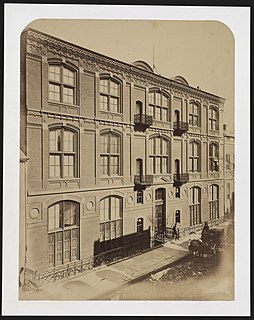
The Tenth Street Studio Building, constructed in New York City in 1857, was the first modern facility designed solely to serve the needs of artists. It became the center of the New York art world for the remainder of the 19th century.

The Elbridge Gerry House is a historic house at 44 Washington Street in Marblehead, Massachusetts. Local lore holds that this house is a c. 1730 house that was the home of merchant Thomas Gerry, and the place where statesman Elbridge Gerry was born in 1744. Stylistic analysis of the house, however, suggests that it is instead a late Georgian or early Federalist construction dating to c. 1790.

Chepstow is an Italianate house museum located at 120 Narragansett Avenue in Newport, Rhode Island, built in 1860. It originally served as a summer "cottage", but the Preservation Society of Newport County now owns the property. It was listed in the National Register of Historic Places as part of the Ochre Point-Cliffs Historic District in 1975 and within the Historic District of the City of Newport.

The William K. Vanderbilt House, also known as the Petit Chateau, was a Châteauesque mansion at 660 Fifth Avenue in Midtown Manhattan, New York City. It was next door to the Triple Palace of William Henry Vanderbilt, which occupied the entire block between 51st and 52nd Streets on the west side of Fifth Avenue.
The Ogden Mills House was a former mansion located on 2 East 69th Street in the Upper East Side of Manhattan in New York City.

The Mrs. William B. Astor House was a mansion on Fifth Avenue in the Upper East Side neighborhood of Manhattan, New York City. It was located at 840 and 841 Fifth Avenue, on the northeast corner of 65th Street, completed in 1896 and demolished around 1926.
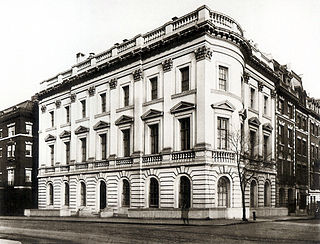
The Mrs. O. H. P. Belmont House was a mansion located at 477 Madison Avenue on the northeast corner of 51st Street in Midtown Manhattan, New York City, New York, United States. The building was demolished in 1951.
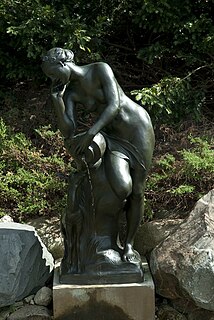
Nymph and Fawn is a public artwork by American artist Isidore Konti and located within the Oldfields–Lilly House & Gardens estate on the grounds of the Indianapolis Museum of Art (IMA), near Indianapolis, Indiana. Created in 1917, the bronze sculpture is also a working fountain. It portrays a female nude pouring water from an urn while standing beside a small fawn.
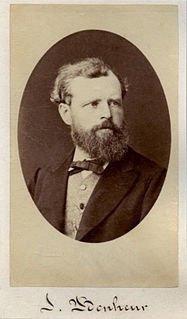
Isidore Jules Bonheur, best known as one of the 19th century's most distinguished French animalier sculptors. Bonheur began his career as an artist working with his elder sister Rosa Bonheur in the studio of their father, drawing instructor Raymond Bonheur. Initially working as a painter, Isidore Jules Bonheur made his Salon debut in 1848.

Franklin Sidway was an American businessman and banker from Buffalo, New York, known for building the Sidway Building in Buffalo, the Spaulding-Sidway house in Grand Island, and commissioning the 1865 painting, Interior with Portraits, by American artist Thomas Le Clear.

Thomas Russell Gerry was an American sailor who was active in the Sons of the American Revolution and was a son of the fifth U.S. Vice President Elbridge Gerry.




















